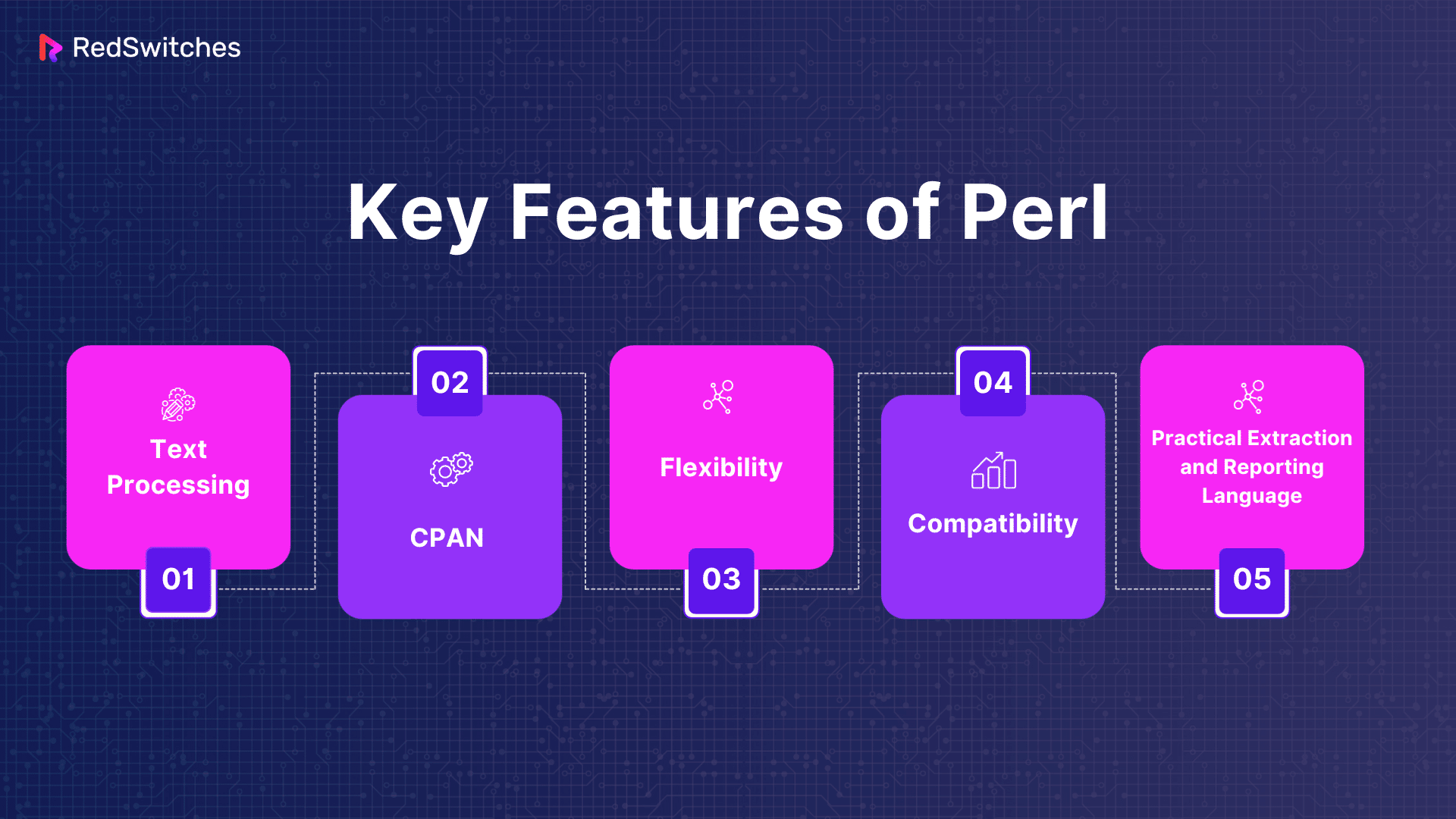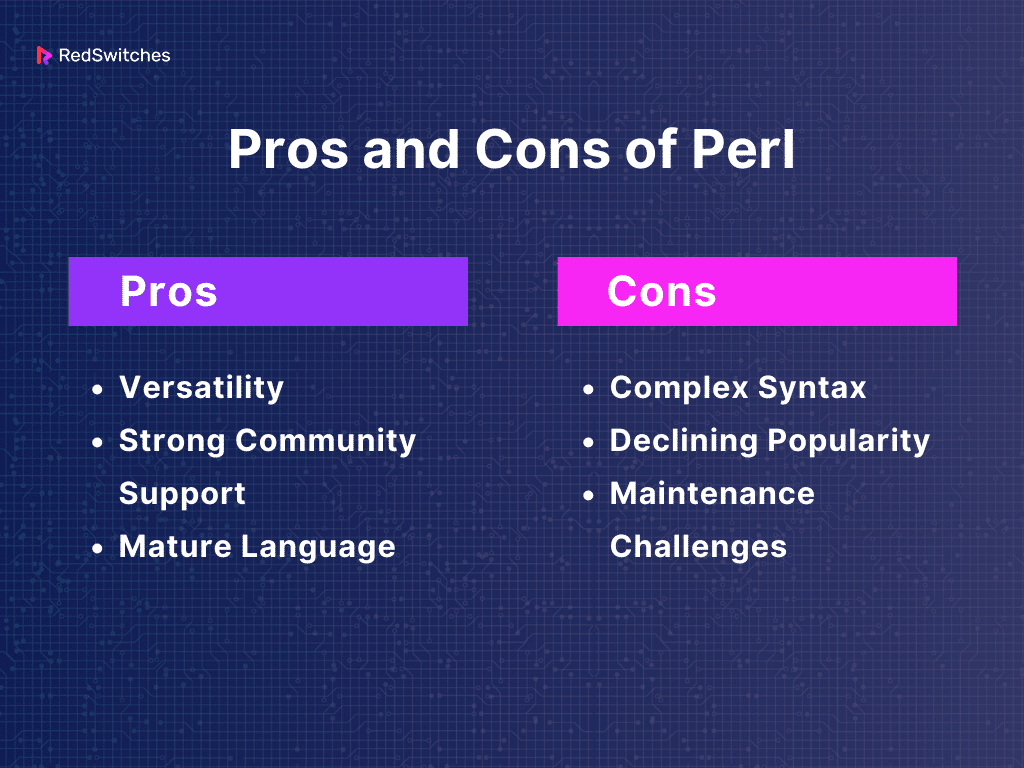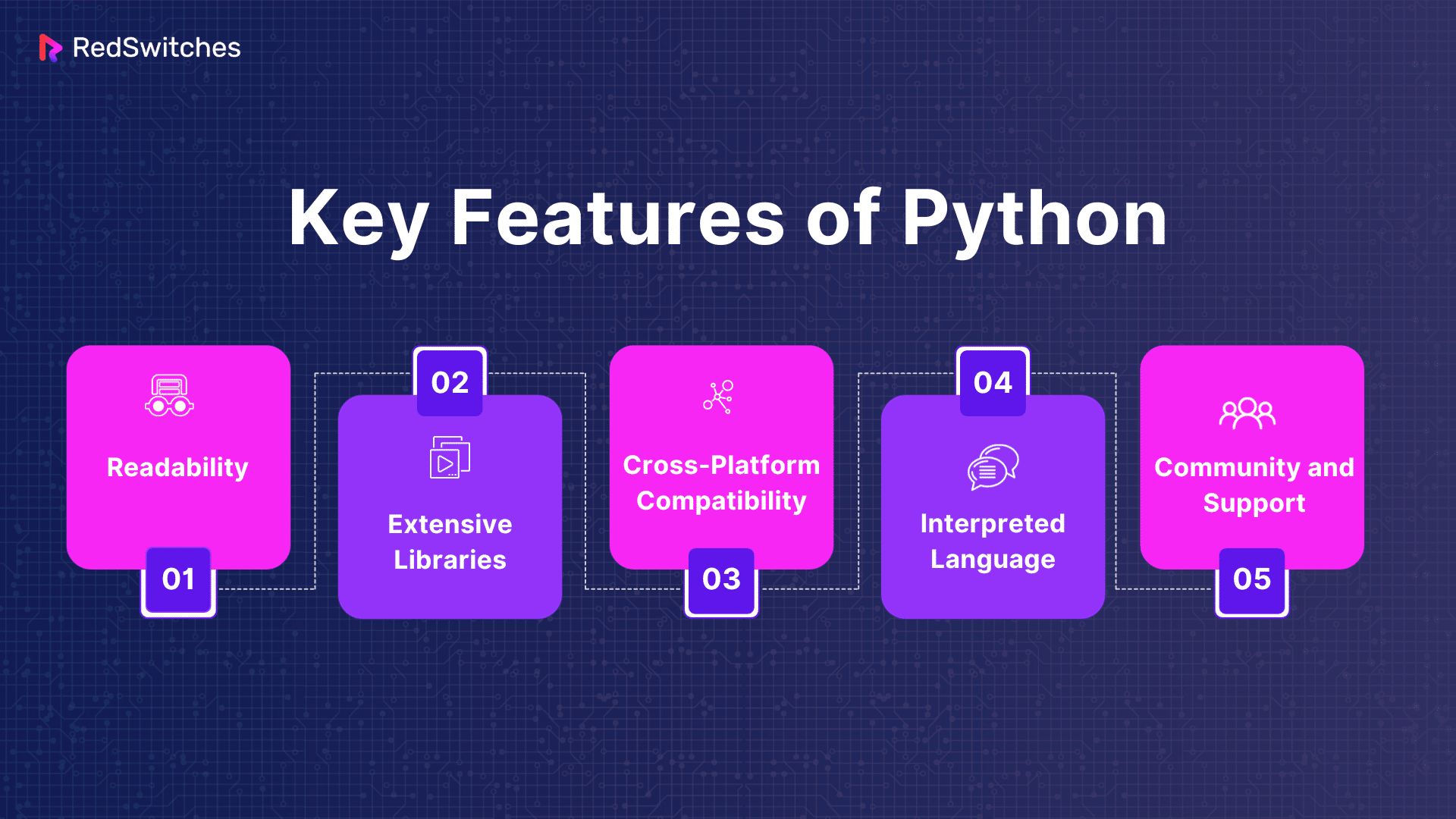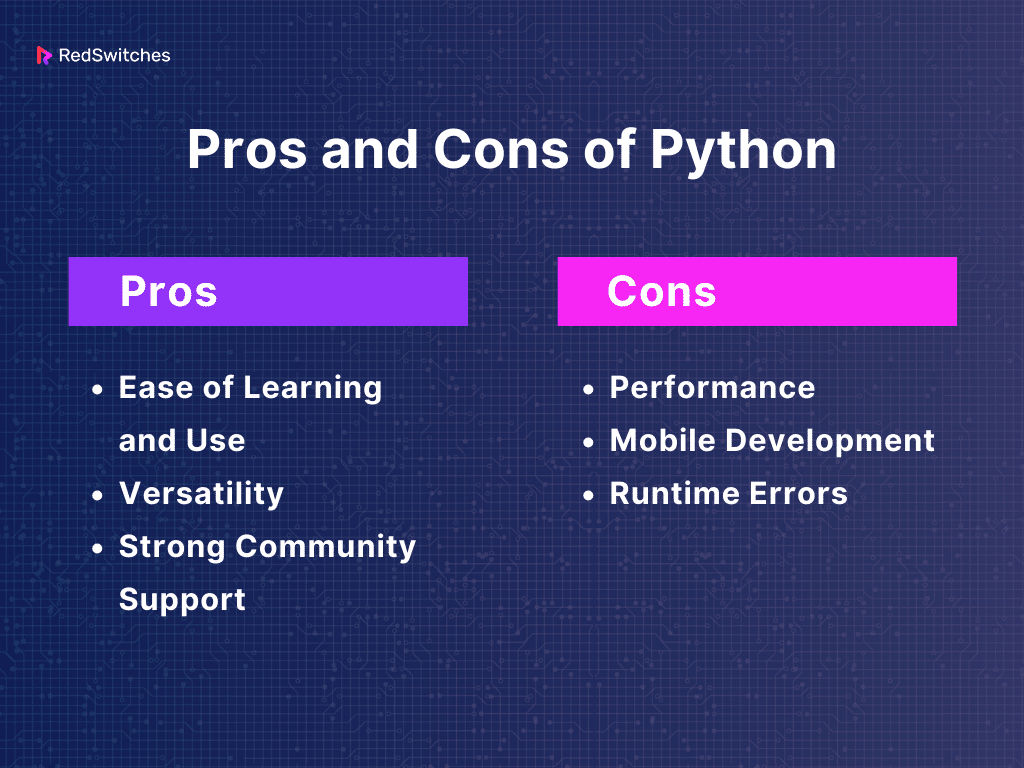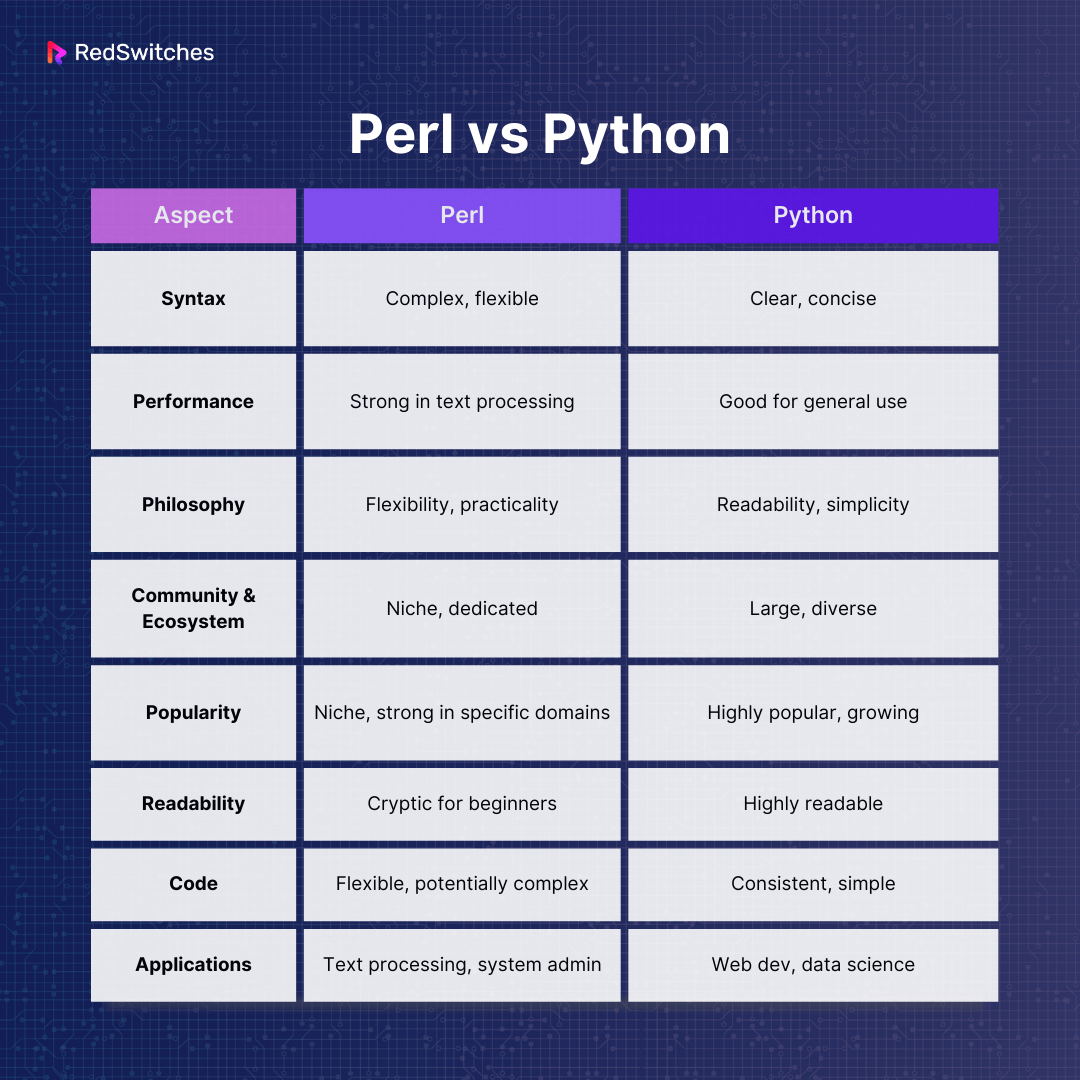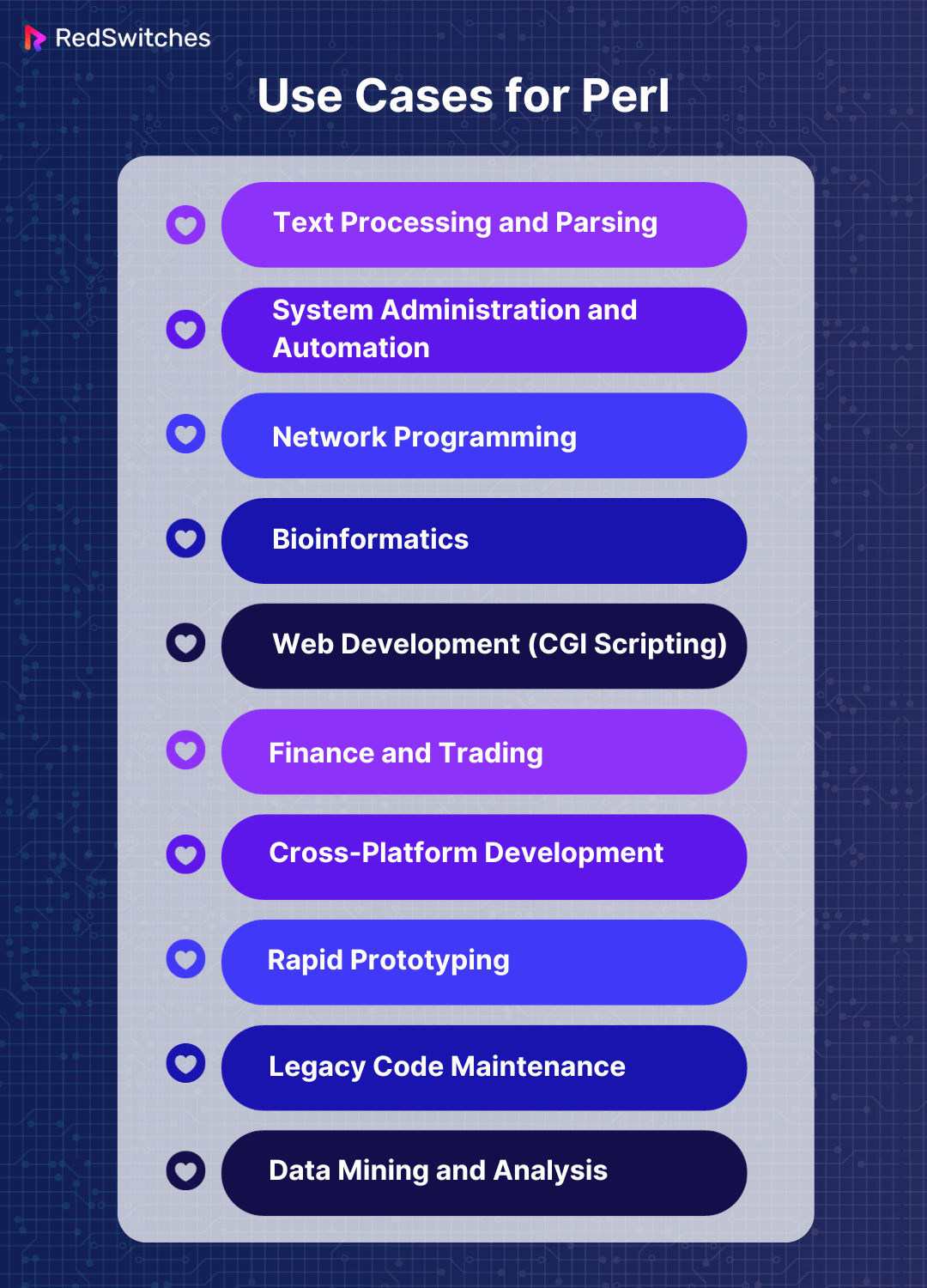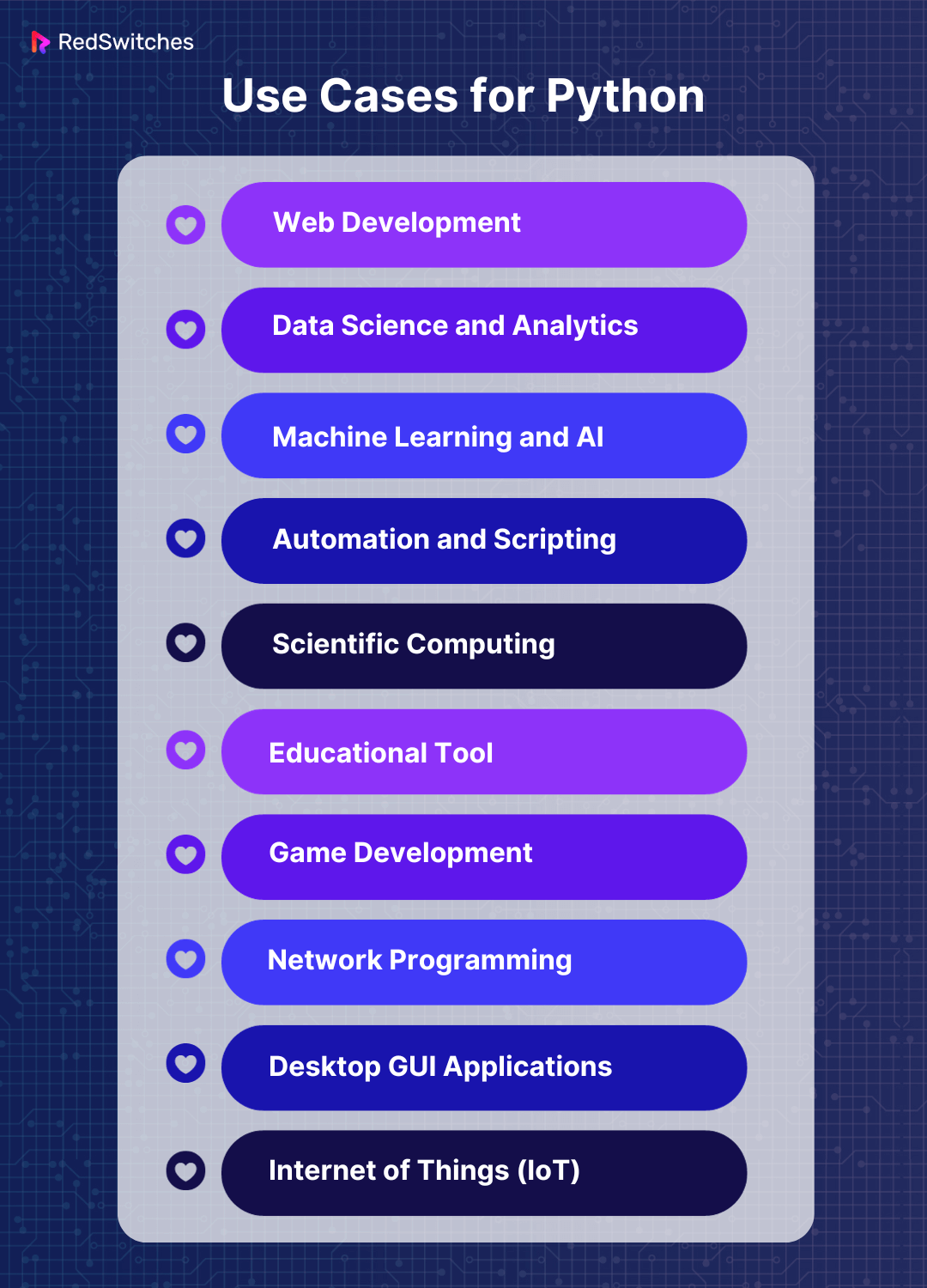In the dynamic and ever-evolving programming world, the debate between Perl vs Python is as relevant today as decades ago. Both languages, admired for their unique strengths and fervent communities, have carved distinct niches in the tech landscape.
Perl, often celebrated for its text manipulation capabilities and scripting prowess, has been a cornerstone in the programming world since its inception in the late 1980s. Python, on the other hand, with its clear syntax and readability, emerged as a powerful, versatile language, quickly becoming a favorite for everything from web development to data science.
Whether you’re just starting in the programming world or looking to expand your existing skill set, this blog promises to be a valuable resource in your decision-making process. Let’s dive into the Perl vs Python world and discover which language is key to unlocking your project’s potential.
What Is Perl?Perl, a high-level, general-purpose, interpreted, and dynamic programming language, is a true testament to the adage, “There’s more than one way to do it.” Developed by Larry Wall in 1987, Perl was initially designed for text processing and has since evolved into a versatile tool for a wide range of programming tasks.
Perl seamlessly integrates features from other programming languages like C, AWK, sed, shell script, etc. Its flexibility and adaptability have made it popular in system administration, network programming, and web development. With its rich regular expression capabilities, Perl has been pivotal in data extraction and text manipulation tasks.
Key Features of PerlAlso read Understanding the Difference Between Linux and Unix: A Comprehensive Guide
Pros and Cons of PerlPerl’s versatility and strength in text processing have cemented its place in the programming world. However, its complex syntax and maintenance challenges are aspects to consider when choosing Perl for a project. As we progress, we’ll see how Perl stands in comparison between Perl vs Python, another giant in the realm of programming languages.
What Is PythonLet’s look at another competitor in our detailed comparison of Perl vs Python. Python is a high-level, interpreted programming language renowned for its simplicity and readability, making it a popular choice among beginners and experts. Created by Guido van Rossum and first released in 1991, Python was designed with an emphasis on code readability and simplicity. This design philosophy promotes clean and pragmatic programming, starkly contrasting with Perl’s “There’s more than one way to do it” approach.
Thanks to its powerful standard library and the vast ecosystem of third-party packages, Python has a wide range of applications, from web development to data science and artificial intelligence. Its syntax, often described as almost pseudo-code, enables developers to express concepts in fewer lines of code than languages like C++ or Java.
Key Features of PythonContinue expanding your Python knowledge by exploring our informative article, “How to Find the Length of a List in Python: Three Easy Methods and Tips.” This guide breaks down simple yet effective techniques to efficiently determine list lengths, a fundamental skill in Python programming. Enhance your coding efficiency and proficiency in handling lists.
Pros and Cons of PythonPython’s simplicity, extensive libraries, and strong community support make it a highly attractive language for various applications. However, when choosing Python for specific projects, its performance limitations and less frequent use in mobile development are aspects to consider. With these insights, we can now move forward with the ultimate comparison of Perl vs Python in various aspects, helping you decide which language to adopt for your specific needs.
Perl vs Python: Key DifferencesThis section will explore the Perl vs Python key differences, focusing on aspects that set them apart. With its eclectic heritage, Perl offers a more flexible syntax and robust text processing capability, making it a go-to choice for scripting and rapid prototyping. Python, on the other hand, with its emphasis on readability and simplicity, has become a favorite in the realms of data science, machine learning, and web development.
By juxtaposing these two languages, we aim to provide a comprehensive overview highlighting their strengths and weaknesses. This exploration will aid seasoned developers in making more informed choices and help beginners understand which language best aligns with their learning trajectory and project goals. Let’s dive into Perl vs Python, unraveling the defining and distinguishing characteristics.
Syntax DifferencesWhen comparing Perl vs Python, one of the most striking distinctions lies in their syntax. The syntax of a programming language is not just about how code is written; it shapes how programmers think and solve problems. Let’s delve into how Perl and Python differ in this fundamental aspect.
Perl Syntax:Complex and Flexible: Perl’s syntax is known for its complexity and flexibility. It borrows elements from programming languages like C, shell scripting, AWK, and sed. This eclectic mix results in a syntax that often seems dense and cryptic, especially for beginners.“There’s More Than One Way To Do It”: This philosophy in Perl allows multiple ways to accomplish the same task. While this fosters creativity, it can also lead to less readable code, especially for those unfamiliar with Perl’s idiomatic expressions.Regular Expressions and Text Manipulation: Perl excels in its regular expression and text manipulation capabilities, which are deeply integrated into its syntax. This makes complex text-processing tasks more straightforward in Perl than in many other languages.Python Syntax:Clarity and Simplicity: Python’s syntax is highly readable and clean. It emphasizes simplicity and minimalism, making it an excellent choice for beginners. Python’s syntax is often described as “executable pseudocode” due to its clarity.Indentation as a Syntax Element: Unlike many other languages, Python uses indentation to define code blocks. This makes the code more readable and enforces a uniform coding style.Less Flexibility in Expression: Python follows the principle of “There should be one—and preferably only one—obvious way to do it.” This approach reduces the flexibility seen in Perl but leads to more consistent and maintainable code.The difference in Perl vs Python syntax reflects their underlying philosophies and the types of problems they are best suited to solve. With its flexibility and robust text processing capabilities, Perl’s syntax is well-suited for quick scripting tasks and data manipulation. In contrast, Python’s straightforward and readable syntax makes it ideal for larger projects and collaborative development where code maintainability is crucial. Understanding these syntactical differences is key for programmers to choose the right tool for their needs.
Dive deeper into your Python journey with our detailed guide, “How to Check Python Version in Linux, Windows, and macOS: A Comprehensive Guide.” This essential resource offers step-by-step instructions and insights to determine your Python version across various operating systems effortlessly. Enhance your Python expertise and ensure compatibility for your projects.
Performance Comparison
Perl vs Python Performance is critical in choosing a programming language, especially for computationally intensive tasks or applications requiring optimal resource utilization. When comparing Perl vs Python, it’s essential to understand how they stack up against each other in terms of performance.
Perl Performance:Text Processing: Perl has always been renowned for its efficiency in text processing. Its built-in regular expressions and string-handling capabilities make it faster for extensive text manipulation tasks.Compilation to Bytecode: Perl scripts are compiled into a bytecode, which the interpreter then executes. This can lead to faster execution times for certain types of applications.Resource Utilization: Perl can be more resource-intensive, especially for larger applications. Its flexibility and complex syntax can sometimes lead to less efficient code.Python Performance:General-Purpose Performance: While not as fast as compiled languages like C or C++, Python is generally efficient for most general-purpose programming tasks. Its performance is often sufficient for web development, simple games, and desktop applications.Optimization Through Libraries: For tasks like scientific computing and data analysis, Python’s performance can be significantly enhanced through libraries like NumPy and SciPy, which are optimized and often use C/C++ in the background.Global Interpreter Lock (GIL): Python’s GIL is a mutex that protects access to Python objects, preventing multiple native threads from executing Python bytecodes simultaneously. This can be a limiting factor in CPU-bound and multi-threaded code.When considering performance, looking at the specific use case is essential. For tasks that involve heavy text processing and pattern matching, Perl might have an edge due to its optimized handling of these operations. However, for more general-purpose programming, Python’s performance is often more than adequate, and its vast array of optimized libraries can bridge the gap in more computationally intensive tasks.
Moreover, the real-world Perl vs Python performance difference may not be significant for many applications. The choice between them should also consider other factors like readability, community support, and the specific requirements of the project at hand.
Philosophy: The Underlying Principles of Perl and Python
The philosophy of a programming language shapes its design, usability, and the community around it. Perl vs Python, while both powerful and versatile, are founded on distinct philosophical principles that influence how they are used and the types of solutions they are best suited for.
Perl Philosophy:“There’s More Than One Way To Do It” (TMTOWTDI): This is the defining mantra of Perl. It emphasizes flexibility and creativity, allowing programmers to approach problems in various ways. This philosophy caters to the notion that different programmers have different ways of thinking and problem-solving.Practicality and Efficiency: Perl was designed for the practical needs of programmers, particularly for tasks involving text processing and system administration. It’s meant to make easy tasks and complex tasks possible.Linguistic and Eclectic Approach: Perl borrows features from various programming languages, such as C, sed, AWK, and shell script. This makes it a rich, albeit complex, language in terms of syntax and capabilities.Python Philosophy:“There Should Be One—And Preferably Only One—Obvious Way To Do It”: This principle, often called the “Zen of Python,” emphasizes readability and simplicity. It suggests that the language should encourage unambiguous solutions.Readability Matters: Python was designed with code readability as a top priority, evident in its syntax and structure. This makes the language more accessible to beginners and maintains consistency in large projects.“Batteries Included”: Python adopts this philosophy by providing a comprehensive standard library that covers a wide array of programming needs. The idea is to offer a rich set of tools and modules within the language.Perl vs Python philosophical differences are reflected in their syntax, community culture, and the types of problems they are commonly used to solve. Perl’s philosophy leads to an incredibly flexible language that is powerful for specific tasks like text manipulation, scripting, and rapid prototyping. On the other hand, Python’s philosophy creates an environment that values clarity and simplicity, making it suitable for larger projects, collaborative development, and web development, data analysis, and machine learning.
Understanding these philosophies is crucial for programmers, as it helps in choosing a language that aligns not just with the technical requirements of a project but also with the programmer’s way of thinking and problem-solving.
Community and Ecosystem
The community and ecosystem surrounding a programming language are vital components that contribute to its growth, sustainability, and applicability. Both Perl and Python boast active communities and rich ecosystems but differ in scale, focus, and resources.
Perl Community and Ecosystem:CPAN (Comprehensive Perl Archive Network): CPAN is at the heart of Perl’s ecosystem, providing a vast repository of modules, scripts, and documentation. It’s a powerful resource that allows Perl developers to find and share solutions.Strong Scripting and System Administration Focus: The Perl community has traditionally been strong in scripting, text processing, and system administration. This is reflected in the types of modules and resources available.Niche but Dedicated Community: While the Perl community may not be as large as it once was, it remains dedicated and active. Perl mongers’ groups, Perl workshops, and conferences like the YAPC (Yet Another Perl Conference) keep the community vibrant.Python Community and Ecosystem:PyPI (Python Package Index): Similar to CPAN for Perl, PyPI is a repository of software for the Python programming language. It hosts thousands of packages covering various programming needs.Diverse Applications: Python’s community is vast and diverse, with strong representation in web development, data science, artificial intelligence, and scientific computing. This diversity is reflected in the vast array of packages and modules available.Global Reach and Popularity: Python enjoys immense popularity and has a large, global community. This is supported by many tutorials, courses, forums, and events like PyCon, enhancing learning and collaboration.Both communities offer extensive support and resources but cater to different audiences and needs. Perl’s ecosystem is highly valued in niches that require advanced text processing and system administration capabilities. With its broader scope, Python’s ecosystem caters to a wider range of applications, particularly those in the rapidly growing fields of data science and machine learning.
The strength of a programming language’s community and ecosystem can significantly influence a developer’s experience. A rich ecosystem offers ready-made solutions and comprehensive support, reducing development time and learning curves. Therefore, considering the nature and strength of their respective communities and ecosystems is crucial when choosing between Perl and Python, especially regarding the support and resources available for your specific project needs.
PopularityPopularity is an important metric to consider when comparing programming languages, as it can indicate the level of community support, job market demand, and the continuous development of the language. Perl vs Python popularity has evolved differently over the years, reflecting shifts in the programming landscape.
Perl Popularity:Early Dominance: Perl was extremely popular in the late 1990s and early 2000s, particularly in web development and scripting. It was one of the go-to languages for CGI scripting and played a significant role in the early growth of the web.Decline in Popularity: Over time, Perl’s popularity has waned. The rise of other languages, particularly Python, which offer similar capabilities with more accessible syntax, has led to a gradual decline in new adopters of Perl.Dedicated but Smaller Community: While Perl’s community may not be as large as it once was, it remains active and dedicated. Perl continues to be used in many legacy systems, particularly in system administration, network programming, and financial services.Python Popularity:Rapid Growth: Python has seen a remarkable rise in popularity over the past decade. Its ease of use, readability, and versatility have attracted many new programmers.Dominance in Emerging Fields: Python’s growth is particularly evident in fields like data science, machine learning, and artificial intelligence, where its simplicity and the extensive availability of libraries have made it a preferred choice.Widespread Adoption in Education and Industry: Python is commonly used in educational settings for teaching programming. It’s also been widely adopted in various industries, making it one of the most in-demand skills in the job market.To further enhance your programming skills and broaden your toolkit, don’t miss our guide on “How to Install pip on Mac.” This step-by-step tutorial will equip you with the knowledge to effortlessly manage Python packages, ensuring you’re well-prepared for any Python project.
The current popularity trends show Python as a more widely adopted language across various sectors, partly due to its ease of learning and the vast array of applications it supports. Although less popular now compared to its peak, Perl still holds a significant place in specific domains where its powerful text-processing capabilities are unmatched.
Perl vs Python Popularity can also be a self-sustaining cycle: more users typically mean more community contributions, better libraries, and more comprehensive learning resources, attracting even more users. For new programmers or those looking to broaden their skills in areas with high demand, these trends in popularity can be a critical factor in deciding whether to learn Perl or Python.
Readability
Readability is a crucial aspect of programming languages, affecting everything from the ease of learning for beginners to the maintainability of code in large projects. Perl and Python, while both powerful, have distinct approaches to readability that reflect their underlying philosophies.
Perl Readability:Complex and Flexible Syntax: Perl’s syntax allows various ways to accomplish the same task, leading to high flexibility. However, this can also result in code that is difficult to read, especially for those not well-versed in Perl’s idiomatic expressions.“Write-Once” Code: Perl’s flexibility and the availability of numerous shortcuts can lead to what is sometimes called “write-once” code – code that can be difficult to understand and maintain by anyone other than its original author.Regular Expressions Integration: While Perl’s integration of regular expressions is powerful for text processing, it can make the code less readable to those unfamiliar with its syntax.Python Readability:Clear and Concise Syntax: Python’s core philosophy is readability, and its syntax is clear and concise, often resembling pseudo-code, making it highly readable and understandable, even for beginners.Indentation and Code Structure: Python uses indentation to define code blocks, which enforces a uniform coding style and enhances readability.“Readability Counts”: This principle in Python leads to a culture of writing code that is not just functional but also easy to read and maintain. Due to this emphasis, Python code tends to be more uniform across different projects.Perl vs Python Readability plays a significant role in the long-term maintenance of code and the ease with which teams can collaborate on projects. Python’s emphasis on readability makes it well-suited for projects where code maintainability and clarity are priorities. On the other hand, while Perl’s flexibility allows for more concise and potentially powerful expressions, it can lead to challenges in readability, especially in larger or more complex projects.
In summary, when choosing between Perl vs Python, it’s essential to consider the context in which the code will be used and maintained. For projects requiring quick scripting and text manipulation, Perl’s expressive syntax might be beneficial. However, Python’s readable and structured approach could be more advantageous for projects prioritizing code clarity and long-term maintainability.
Code
The comparison of Perl vs Python in terms of code involves examining how code is written, structured, and executed in each language. This includes aspects like syntax, conventions, and the overall approach to programming that each language embodies.
Perl Code:Flexibility and Conciseness: Perl allows various ways to write code to accomplish the same task. This can lead to very concise code, often a benefit in scripting and rapid development scenarios.Complex Syntax: Perl’s syntax, influenced by several programming languages, can be complex and challenging to read, especially for those unfamiliar with its nuances. Perl code can incorporate various styles and techniques, making it highly versatile but sometimes less consistent.Regular Expressions and Text Processing: Perl’s code shines in handling regular expressions and text processing, allowing complex operations to be performed with relatively simple and efficient code.Python Code:Readability and Simplicity: Python’s code is highly readable and easy to understand. The language’s design emphasizes simplicity and explicitness, as seen in its clear syntax.Consistency: Python encourages a more uniform coding style compared to Perl. The Python Enhancement Proposal (PEP) 8, for instance, provides a style guide for Python code, promoting readable and consistent code across projects.Versatility Across Applications: Python code can be used effectively across different fields, from web development to data science. Its extensive standard library and third-party modules add to its adaptability.Both Perl and Python have unique strengths and characteristics in terms of coding. Perl’s code is incredibly flexible and powerful for system administration, scripting, and text-processing tasks. However, its complexity and “there’s more than one way to do it” philosophy can lead to less consistency in code style.
Python, emphasizing readability and uniformity, offers a more consistent and often simpler coding experience. Its straightforward syntax makes it a popular choice for many applications, including for beginners and in educational settings.
In the debate of Perl vs Python, one should consider the nature of the project, the team’s familiarity with the language, and the long-term maintainability of the code. Perl might be more suitable for projects that require quick development cycles and advanced text manipulation. In contrast, Python would be the go-to for projects requiring collaborative development and code that is easy to maintain and scale.
Applications
Understanding Perl vs Python typical applications helps determine which language is more suited for a particular project or domain. While there is some overlap in their capabilities, each language has its strengths in specific areas.
Perl Applications:Text Processing and Scripting: Perl’s design and features make it exceptional for text processing and scripting tasks. Its powerful regex and string manipulation capabilities are highly valued in parsing logs, data extraction, and report generation.System Administration: Perl has been traditionally used for system administration tasks. Its ability to handle various tasks like process monitoring, automation of system tasks, and file manipulation makes it a preferred choice in this domain.Web Development: Although its popularity in this field has declined, Perl was once a major player in web development, particularly with the Perl CGI (Common Gateway Interface) scripting.Bioinformatics: Perl remains a significant language in bioinformatics for data analysis and manipulation due to its robust text-processing capabilities.Python Applications:Web Development: Python is popular in web development, especially with frameworks like Django and Flask. These frameworks make it easier to build robust and scalable web applications.Data Science and Machine Learning: Python’s simplicity and the availability of libraries like NumPy, Pandas, SciPy, and TensorFlow make it a top choice for data science, machine learning, and scientific computing.Automation and Scripting: Python is also used for automation and scripting tasks. Its readability and extensive library support make it suitable for automating repetitive tasks and scripting.Educational and Introductory Programming: Python’s simple syntax makes it an ideal language for teaching programming concepts. It is widely used in educational institutions for introductory programming courses.Both Perl and Python are versatile languages, but their primary applications have evolved to leverage their respective strengths. Perl’s powerful text manipulation features make it ideal for tasks that involve extensive text processing and system administration. With its simplicity and extensive libraries, Python has become the language of choice for web development, data science, and educational purposes.
When choosing between Perl and Python for a project, consider the specific requirements of your task. Perl might be the more efficient choice for complex text processing or legacy system maintenance. However, Python’s capabilities and community support make it a more suitable option for newer applications, particularly in web development and data science.
Here’s a comparison table that highlights the Perl vs Python fundamental differences across key aspects, providing a quick reference to understand their unique attributes and typical applications:
Perl, known for its versatility and strength in text processing, finds its niche in several specific applications. Understanding where Perl excels can help in leveraging its capabilities effectively. Let’s explore some of the primary use cases for Perl, highlighting areas where its unique features are particularly beneficial.
Text Processing and Parsing: Perl was originally developed for text manipulation and remains one of the best languages. Its powerful regular expressions and various text-processing features make it ideal for parsing logs, extracting data from files, and automating report generation.System Administration and Automation: Perl is a strong candidate for system administration tasks. Its ability to handle file and directory operations, manage processes, and automate system tasks makes it a valuable tool for sysadmins. Perl scripts can efficiently automate repetitive tasks, manage user accounts, and monitor system performance.Network Programming: Perl’s support for socket programming and its ability to handle various network protocols make it suitable for developing network tools and utilities. Perl can write server and client-side applications for network communication, monitoring, and testing.Bioinformatics: In bioinformatics, Perl is used for sequence analysis, gene mapping, and data parsing from biological databases. Its text-processing capabilities are particularly useful in this domain for handling large datasets of genetic information.Web Development (CGI Scripting): Although other languages have become more prevalent in web development, Perl was one of the pioneers of CGI scripting. It is still used for maintaining legacy websites or in environments where Perl’s specific capabilities are required.Finance and Trading: Perl finds usage in financial applications, particularly for developing trading systems, processing financial data, and automating trading strategies. Its ability to quickly process large volumes of text data is a significant advantage in this sector.Cross-Platform Development: Perl’s cross-platform nature makes it a suitable choice for developing applications that need to run on multiple operating systems without significant changes.Rapid Prototyping: Perl’s flexibility and extensive CPAN library are invaluable for quickly developing a working prototype. Developers can rapidly build and test ideas using Perl’s diverse modules and scripting capabilities.Legacy Code Maintenance: Perl is often used for maintaining and updating legacy systems, particularly in organizations where Perl was extensively used. Its capability to handle older codebases and integrate with existing systems makes it a practical choice.Data Mining and Analysis: Perl’s proficiency in handling and processing giant text files is beneficial for data mining and analysis tasks. It can efficiently parse, analyze, and extract insights from large datasets, making it useful in market research, customer analytics, and academic research.Each of these use cases highlights Perl’s adaptability and efficiency in handling tasks that require robust text manipulation, rapid scripting, and cross-platform compatibility. While Perl might not be the first choice for new web development or application programming projects, it remains a powerful tool in areas that leverage its core strengths, especially in scripting, data processing, and system administration.
Use Cases for PythonPython’s versatility and simplicity have made it a popular choice in a wide range of applications. Understanding where Python excels can help effectively leverage its capabilities for various projects. Let’s explore some of Python’s primary use cases, highlighting its strengths and versatility:
Web Development: Python is widely used in web development, especially with frameworks like Django and Flask. These frameworks simplify the development of robust and scalable web applications.data science and analytics: Python’s ability to handle and analyze large datasets, along with its libraries like Pandas, NumPy, and SciPy, make it a go-to language for data science and analytics.Machine Learning and AI: With libraries like TensorFlow, Keras, and PyTorch, Python is at the forefront of machine learning and artificial intelligence development, allowing for the creation of advanced predictive models and algorithms.Automation and Scripting: Python is an excellent tool for automating repetitive tasks and scripting due to its simplicity and the wide range of libraries available for various automation tasks.Scientific Computing: Python’s use in scientific computing is bolstered by libraries such as NumPy and SciPy, which provide tools for mathematical and scientific calculations.Educational Tool: Python is often the first programming language taught in educational institutions due to its readability and simplicity, making it ideal for introducing programming concepts.Game Development: Python is used in game development, especially for scripting and prototyping, while not as dominant in this field as some other languages. Libraries like Pygame are used for creating simple games.Network Programming: Python’s standard library includes several modules for writing networked programs. It’s used to develop network monitoring, automation, and testing tools.Desktop GUI Applications: Python can be used to develop desktop applications. Frameworks like Tkinter, PyQt, or Kivy enable the creation of user-friendly graphical interfaces. Internet of Things (IoT): Python’s simplicity and scalability make it a suitable choice for IoT applications, where it’s used to develop and manage connected devices and systems.Each use case demonstrates Python’s adaptability and ability to cater to various programming needs. Python’s straightforward syntax and extensive libraries make it an excellent choice for various applications, from web development and data science to educational purposes and automation.
ConclusionAs we end our journey through the intricate landscapes of Perl vs Python, it’s clear that both languages have carved out their unique niches in the programming world. With its powerful text manipulation capabilities, Perl remains a stalwart in scripting, data processing, and system administration. On the other hand, Python shines in its simplicity and versatility, making it the language of choice for web development, data science, machine learning, and much more.
The choice between Perl vs Python ultimately hinges on the specific needs of your project and your goals as a developer. Whether it’s leveraging Perl’s powerful text processing for complex data manipulation tasks or harnessing Python’s readability and extensive libraries for cutting-edge applications, each language holds the potential to transform your ideas into reality.
Now, if you’re ready to take your projects to the next level, RedSwitches is here to assist you. With our expertise and resources, we can help you navigate these programming languages to find the perfect fit for your needs. Whether you’re looking to optimize an existing application, embark on a new project, or seek advice on which language best suits your objectives, RedSwitches is your go-to partner.
Don’t let the complexity of choice slow down your innovation. Connect with RedSwitches today, and let’s unlock the full potential of Perl and Python together, propelling your projects forward with the right tools and expert guidance. Visit us at RedSwitches and start your journey towards programming excellence with our Dedicated Server.
FAQsQ. Is Python better than Perl?
The question of whether Python is better than Perl depends on the specific requirements of a project. Python is often preferred for its readability, simplicity, and wide-ranging applications in web development, data science, and machine learning. Perl, however, excels in text manipulation and scripting tasks. Both have their unique strengths.
Q. Is Perl still in demand?
Yes, Perl is still in demand, particularly in niches like system administration, network programming, and bioinformatics. While its popularity has declined compared to newer languages like Python, Perl remains valuable for certain specific applications, especially where its powerful text-processing capabilities are required.
Q. Is Perl part of Python?
No, Perl is not part of Python. They are distinct programming languages, each with its syntax, design philosophy, and use cases. They were developed independently of each other and have different communities and ecosystems.
Q. Is Perl difficult to learn?
Perl can be challenging to learn, especially for beginners, due to its complex syntax and the philosophy of “There’s more than one way to do it.” This flexibility allows for a powerful and expressive language. Still, it can also lead to less straightforward and more cryptic code, making the learning curve steeper compared to more straightforward languages like Python.
Q. What are the key differences between Perl and Python?
The main differences lie in their syntax, use cases, and community support. While Perl is known for its text processing capabilities and regular expression handling, Python is favored for its readability, simplicity, and versatility for web development and large-scale applications.
Q. Which programming language is best for web development, Perl or Python?
Python is generally considered to be better suited for web development due to its wide range of frameworks and libraries, such as Django and Flask, as well as its clean and easily maintainable code structure.
Q. What are the primary areas where Python excels compared to Perl?
Python excels in areas such as ease of learning, code readability, support for complex data structures, and seamless integration with other languages and tools.
Q. In what aspects does Perl have an edge over Python?
Perl is well-known for its powerful text processing capabilities, extensive support for regular expressions, and a rich set of built-in features suitable for handling complex string manipulations and system tasks.
Q. What are the similarities between Python and Perl?
Both Python and Perl are widely used scripting languages, equipped with strong community support, and are capable of handling various programming tasks, including web development, system administration, and data analysis.
Q. Is Python easier to learn compared to Perl?
Yes, Python is generally considered easier to learn due to its clear and concise syntax, which makes it more readable and approachable for beginners and experienced developers alike.
Q. Does Python require a semicolon at the end of the line like Perl?
No, Python does not require a semicolon at the end of each line, whereas in Perl, the semicolon is required to terminate statements.
Q. Which language is best for text processing, Python or Perl?
Perl is traditionally recognized as very strong in text processing due to its built-in features for regular expressions, making it a preferred choice for handling complex textual operations.
Q. Can Python be used for CGI scripting and web development like Perl?
Yes, Python can be used for CGI scripting and web development, with frameworks like Django and Flask providing comprehensive support for building dynamic web applications and handling server-side scripting tasks.
Q. Is Python used for a wide range of applications like Perl?
Yes, Python is used for a wide range of applications, including web development, scientific computing, data analysis, artificial intelligence, machine learning, and system administration, making it a versatile and popular choice among developers.
